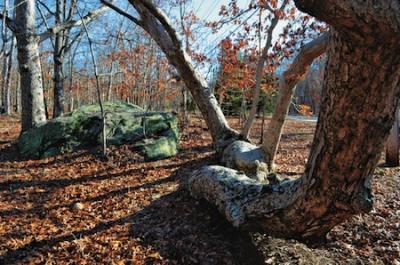Nature Notes: Living Boundary Markers

The South Fork of Long Island and, in particular, East Hampton Town have a quasi-natural feature that few other areas in the United States can claim, the “lop tree.” Lop trees, or boundary marker trees, are scarce in Southampton Town but abundant in East Hampton, especially so in the Northwest, Springs, and Amagansett areas.
As the name suggests, these trees, almost all of which are white oaks, were formed by lopping off the stem above one of the early lateral branches when the tree was but a mere sapling with loppers, or pruners. As the tree matured, it grew out rather than upward.
Yet the process of lopping was not finished; there was still a lop to make. As soon as the lateral branch sent up a vertical shoot — nature’s way of allowing a tree pushed over by winds but still partially rooted to recover — the lateral branch was lopped off just beyond the origin of the new shoot. If the lopper did a good job and, from the look of it, there were some very fine lop-tree fashioners in the early history of East Hampton, in 20 years’ time you had a tree that formed a kind of chair or three-quarters of the numeral four.
There was another trick to the first cut. It was best if the horizontal branch selected was in line with the boundary that the tree was cultured to represent. Almost 90 percent of the hundreds of boundary trees I have looked at in 30 years of backwoodsing East Hampton not only mark the edge of a parcel’s boundary line, but also tell the observer the directional course of it. In many cases a few hundred feet down the line there is a second lop tree with its horizontal trunk pointing in the same direction as the first one’s.
This meshing of horizontal trunk direction with a survey line’s course can be readily seen on the periphery of the Duke Estate on the east side of Springy Banks Road just south of its junction with Hand’s Creek Road, the site of one of the most magnificent and oldest lop trees in the town. This particular lop tree has the longest horizontal portion of any boundary tree that I have observed locally. It is more like a bed than a seat.
In studying several of these trees, I have found almost all of them to be more than a century old. Why was the white oak picked for this job by early surveyors and woodsmen? Most likely for three reasons: It was a common tree on eastern Long Island, it was the longest living of the local oaks, and the bark was a very light gray, almost white. Thus a white oak lop tree could be seen in the woods at a distance, because of its light hue and its shape.
It has been suggested by some anthropologists that lopping was a trick the early settlers learned from the local Native Americans, who taught the first whites on Long Island so many things to make their lives easier. Whether this is so or not, the lop trees do have a kind of spiritual presence. Not only do they tell us something about the early days, but also their venerable aspect is not so different from that of boundary trenches, old rock piles, even old stone walls, all of which were used by the early inhabitants to demarcate boundaries. The lop trees, however, are the only living relics of the bunch.
The fact that very few lop trees have been damaged or cut down by the hands of man over the years shows that they are somewhat revered by the town’s residents. Many generations of town Highway Departments have been particularly careful not to remove or alter them. No doubt many wild mammals and birds take notice of them in defining their territories.
Unfortunately, some recent big blows such as Irene and the post-Christmas storm of 2010 have done in a few old lop trees, say, along the town trustee road to the end of Barcelona Point and one or two of those along Accabonac Road where it passes by a town nature preserve. Lop trees are sturdy and long-lived but their lower trunks, including the horizontal part, are often hollow, belying a certain vulnerability when challenged by strong winds.
The George Walbridge surveyors have taught me a lot about lop trees. In these parts surveyors and lop trees are often bonded. Field crews frequently encounter them in their survey work. Among that local group, David Weaver has personally related to me on more than one occasion how many of these trees are smack-on-center of survey lines that are still current but date back 100 years or more. David was also the one who pointed out to me that of the four presidential faces carved on Mount Rushmore, three of them belonged to surveyors.
Surveying is one of the oldest occupations, every bit as old as lawyering, and lawyering is almost as old as prostitution.
